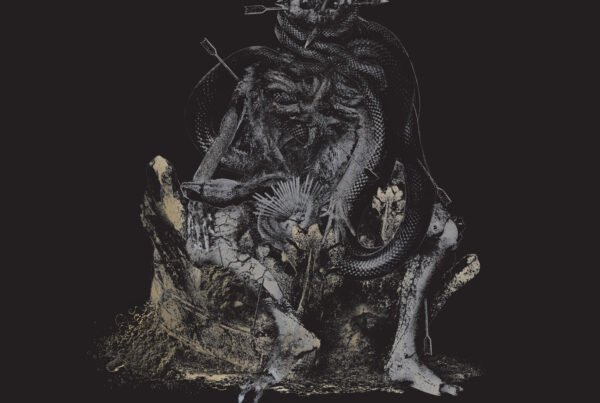Today, me and fellow writer Xander team up for our second overall joint conversational review. This time, we are discussing in depth Keygen Church’s new album, ░█░█░░█░█░█░. A bit of background first, before we delve right into the action. Keygen Church, as well as MASTER BOOT RECORD, are the sonic outlets of aural mastermind, Vittorio D’Amore. Shrouded in mystery, over the course of fifteen albums, we receive an unparalleled and explosive musical package that bends styles and genres to its own twisted will in order to portray something that is nothing short of a remarkable and inspiring experience.
Xander: Hey man, how’s it going?
Robert: It’s all good — mindlessly droning through YouTube vids with some welcome downtime at work — yourself?
X: Doing all right, I’m filling my downtime at work by madly refreshing vaccine appointment websites. Seems like we are hovering at similar levels of productivity at the moment.
R: Sounds about right. I actually switched just now to ░█░█░░█░█░█░ for that extra immersive kick while we discuss it. What’s your first impression of it?
X: Well, to keep it simple, I was surprised at the maturity and restraint on display in this record. D’Amore maintained Baroque stylistic leanings at the forefront of the record this time around. I mean, the thing just drips Bach and Vivaldi. Did you feel similarly, or was ░█░█░░█░█░█░ par for the course as far as Keygen Church goes?
R: In a broad sense, I guess I can agree with that, although I’d like to point out that the symphonic element reaches into some Romantic territory aside from Baroque.
What exactly are you referring to as mature and restrained though? I’m not sure I’m getting that part.
X: I definitely agree on the Romantic elements, but I’ll defer discussing that for now, and perhaps leave to you to elaborate and, well, maybe maturity and restraint aren’t the right words. There are certainly moments of decadence on this record that we see pretty prominently in Keygen Church‘s past works — for example, the virtuosic piano runs on “A S G R E T A L O S” are not restrained at all, and we see similar wankery all over the place on Keygen‘s previous record, ░ ▒ ▓ █.
I suppose that when I say ‘maturity’, what I am really trying to articulate is that I find the song structures and chord progressions the most compelling on this release, when compared to Keygen‘s prior releases, if that starts to answer your question.
R: I don’t feel like there’s anything to nitpick about the Romantic element. I just wanted to state its presence as, maybe, it’s just enough of a prod for listeners who can’t pinpoint what they want to articulate in that direction. I’d say it’s something that most overtly shines through the wildly gothic atmosphere and epic demeanor of the songs.
Also, yes, that’s why I needed clarification with that maturity/restraint remark, hahaha.
░█░█░░█░█░█░ is basically as self-indulgent as any other MBR or Keygen Church album. While I’d normally have qualms with this type of track record, I actually encourage this path in this case.
I think that what we’re receiving is a great service in the form of a lot of a kind of music which isn’t exploited, even if, between albums, there isn’t any amazing variety or groundbreaking levels of composition.
X: You touch on a point I’ve been pondering a lot lately, which is how to evaluate a project within an artist’s broader body of work. I’m sure I can speak for the both of us, as writers at Everything Is Noise, when I say that I tend to get frustrated when an artist retreads territory that they’ve explored in the past.
Could you elaborate on why you give Keygen Church a pass on this, maybe expanding on what you said regarding creating music in a new frontier where there isn’t really any existing precedent?
R: Yeah, it’s hardly ideal for me as a listener to basically be greeted with the same record twice from the same artist. Sure, there are instances where something like that is understandable or expected. This is one of those rare cases where it’s welcome from my point of view. I mean, name another goth synthesized/chiptune/metal/Baroque/Romantic, 8bit-tinged, pipe-organ-laden band: I’ll wait. Though, I think it will definitely loose its pass once someone else does this but better in every way, or with a twist that feels like an improvement. The same applies for MBR, but keeping its particular stylistic hallmark in mind.
Of course, I would much rather take something that is a step forward musically even in these conditions, instead of another step on the spot. However, ultimately, I take what I can get — no shame in that whatsoever.
Also, the quality is consistent and I’m a massive sucker for music that incorporates Baroque and/or Romantic elements with a metal backdrop. Yes, I’m heavily biased and I hope no one expected otherwise, because the disappointment is theirs alone.
X: Well said. I’m cautiously optimistic that we’ll see future gothcore releases, because synths and 8-bit stylings are all the rage in certain metal scenes these days.
Before I get too off topic, though, I think we should talk about why ░█░█░░█░█░█░ is worth listening to. It’s not just the novelty, and it’s not just that both you and I happen to be reformed Neoclassical metal enthusiasts who have a soft spot for this sort of thing. The LP is full of drama and emotion, and each track has a distinct personality. Most of all, Vittorio D’Amore clearly respects and loves his Romantic/Baroque forebearers, as he places the hallmarks of their stylistic signatures at the forefront of his work. If you can tolerate an unwieldy analogy, D’Amore adds a fresh layer of metallic paint to the race car without disturbing the integrity of the BaroMantic engine at its core. The resulting synthesis is catchy, technically impressive, and well worth repeated listens. This album bangs!
R: Folks, if ‘gothcore’ becomes a thing, you heard it here first. Moving on though, D’Amore clearly pays a generous homage to our cornerstone musical forefathers, even if there’s nothing new — in a sense — to articulate in that direction.
This homage is, without a doubt, perfectly executed and it indeed manages, together with its modern counterparts, to create massive emotions. Although, to be fair, it’s hard to be subtle when half of your record is peppered with pipe organs.
I must say your analogy is wild as fuck and I love it. It feels like it’s out of one of those golden-era Cracked articles from the late ’00s.
X: I appreciate the reference to Cracked. If we could conduct a full write-up on MBR/Keygen Church in a Cracked style, I’d have a field day: “17 Reasons You Should Stop What You’re Doing and Include a Pipe Organ in Your Lo-Fi, Raw Black Metal Toaster Dem”; “Who is Franz Liszt, Why You Should Care, and Why He Is Better Than Frederic Chopin?”; “23 Forgotten Key-Encoded Messages from MBR’s Vittorio D’Amore That Indicate He Could TOTALLY Get It”.
Anyway. Would you like to take the steering wheel away from me before the editorial slams the brakes?
R: I’m kind of mad how you basically took away the best possible titles for this context and I have nothing to add, but at the same time I’m scintillating with joy that my inner monologue stemming from that Cracked analogy wasn’t lost.
Anyway, I’ll gladly take the wheel before this becomes a total wreck.
I’m genuinely curious if anyone at all managed to solve any of D’Amore’s wild and cryptic cryptographic puzzles for what are the rarest of his songs. Even if someone did, there doesn’t seem to be any clear indicator of this. Nor has anyone leaked any of the songs, which, if puzzles were solved, makes for what must be the most tightly knit fan base with the most distinguished sense of camaraderie out there.
It seems that Keygen Church makes no exception and includes the stanzas that act as clues as well as the characteristic block of text to be decrypted via AES 256-bit.
I actually really wanted to highlight how madly good “G E B U E R J E I T” is, among other things. It just hits so hard on so many levels. It starts out with a mellow pace, with a lone piano, only to then burst suddenly into an absolutely grand atmosphere, which feels like walking through a cathedral the size of several castles, adorned with dark cyberpunk ornaments side by side with its original and nigh opulent Renaissance aesthetic.
It’s so grand, it feels almost anthemic, feeding this larger-than-life kind of mood which is promptly followed by a good heap of chromatic scales that just glide so neatly it’s surreal. Then, just as we approach the fifth minute, we get a madly satisfying breakdown cut with more of this chromatic stuff, all while sustained by our trusty pipe organ. It’s simply stunning. I think I already listened to this song like 30 times today and I may be underestimating the actual count.
X: I’m really glad you mentioned D’Amore’s fascination with cryptography. If you browse Keygen Church’s Facebook pages, there are quite a few dedicated fans who have spent a good deal of time grappling with (and supposedly solving!) D’Amore’s puzzles, which can even intertwine with one another. These puzzles represent yet another oddball characteristic of D’Amore that makes him so magnetizing. and the whole mystique that he develops serves to amplify the Banksy-like persona he has cultivated, whether intentionally or not. The man is an artiste and auteur of the highest order, and wherever the genre goes we should always remember him as the ‘High Priest of Gothcore’.
I’m also glad you brought up the album’s masterpiece. I couldn’t agree more with your write-up and have not much of substance to add: “G E B U E R J E I T” sounds like the soundtrack to the final boss fight on a bootleg Castlevania game. While other tracks also make me want to don a bandana and kill some vampires, this one carries an extra sort of heft. At the risk of seeming hyperbolic, it has this near-religious grandiosity to it. I think this track is where D’Amore really took things up a notch.
While there are plenty of gems scattered across the LP (the aforementioned “A S G R E T A L O S” and “D I L E R K E F E T” to name just two), they manage to sound slightly interchangeable with previous Keygen Church tracks. We’ve already discussed that this cross-album interchangeability isn’t such a bad thing given the unique artistic moment D’Amore is exploring here. I’m fine with him operating mainly on consistency of sound if it means we get treated to the occasional “G E B U E R J E I T” magnum opus once a record.
R: Except for “G E B U E R J E I T”, I could probably hear any part of this album and mistake it for any part of the other two predecessors. Like I said, while this isn’t ideal, it does give us a good sense of how consistent D’Amore is with his work. He clearly has a very well defined and uniquely fleshed-out vision of the art he creates. It is also obvious that, for a one man project, his works are not nearly half as self-indulgent and derivative as most one-man bands tend to be.
At the end of the day, ░█░█░░█░█░█░ is simply a fun ride. I don’t think D’Amore takes his work so seriously as not to be aware of this, particularly. It’s not a kind of, say, high-impact, high-concept, progressive fusion madness that deems itself profound like some absolute truth in life. It’s simply the conjuration of realms which are far from us, but close to him, and as such he imparts with us the experience of treading through this surreal and nebulous metaverse — hence why I referred earlier to all of this as a service, ultimately. You can’t call it otherwise given the amount of work and the amount of quality which is spread out across it — a great track record for someone this prolific. Of course, the creative medium and means also lend a hand in the convenience of crystallizing such ideas.
░█░█░░█░█░█░, just like any other album of his, kind of redefines what we’ve come to expect from a fun ride. Even with what could objectively called a superfluous track record, there’s still a veritably high engagement factor throughout all of his works. It would go without saying that fans of the genre are going to love the fuck out of this album, as it keeps the same standard as any others. ░█░█░░█░█░█░ takes the complex parts of its influences and makes for a digestible and energetic listen. At the same time, the record is also charged with an arduous thespian spirit which only adds to its immersive qualities. Finally, I guess we already established that the scale of all the presented sentiments borders on a pious magnificence.
X: Couldn’t agree more. You’ve crystallized an important part of how I view D’Amore’s aesthetic, as filtered through the lens of Keygen Church. D’Amore’s work doesn’t quite stretch the boundaries of the musical frontier for others to follow behind in lockstep. Rather, each Keygen Church release pulls the listener deeper and deeper into D’Amore’s uniquely crafted world, populated by gothic organs, heavy synths, the odd double bass pulse, and a surprisingly deep ‘lore’ of coded messages. While there is massive fun to be had in headbanging to a literal pipe organ on ░█░█░░█░█░█░, it’s fulfilling and gratifying from a fan’s perspective for an artist to lure you into something that is so essentially ‘them’ in this way.
Key to the uniqueness of D’Amore’s identity (both for Keygen Church and MBR) is the ‘thespian’ spirit you mentioned. This rare sensibility is present in very, very, very few serious metal artists nowadays — in fact, I’d venture to say Old Nick of Grime Stone Records is the only project I’d rank as D’Amore’s peer in terms of sheer worldbuilding and individuality. I don’t care if every blackened death metal band these days wants to be Gorguts, or if tech death groups continue to reheat old Lamb of God records in a djenty microwave. Call me a lowbrow aesthete if you like, but I expect that D’Amore’s next dozen Keygen Church and MBR albums to continue to be as entertaining, complex, and addictive as they have proved to be thus far.
R: I am 100% on board with all of that. I just want to add, even if it’s only (or not) vaguely and tangentially related — I feel that maybe Toby Driver‘s projects, maudlin of the Well, and Kayo Dot have similar, if not more enthralling worldbuilding. Anyway, I think this pretty much covers the record. Would you have anything else to add?
X: Wouldn’t expect anything less than a sneaky shout-out to Toby Driver at the end of the review from the likes of you, but point well made. I think we’ve done Keygen Church’s eminently pronounceable new record the justice it heartily deserves. To all the future gothcore mavens out there, what are you waiting for? ░█░█░░█░█░█░ awaits. Set aside your whip, cross, and holy water when entering the cathedral, please.






